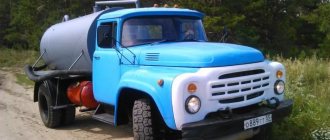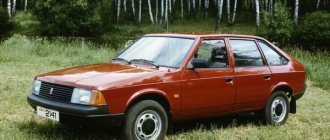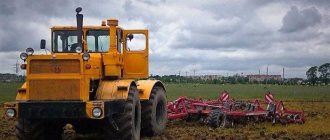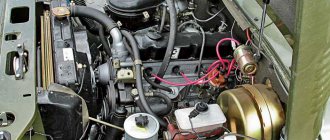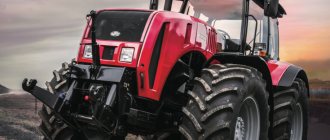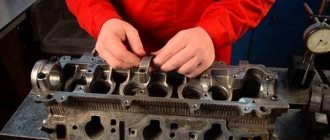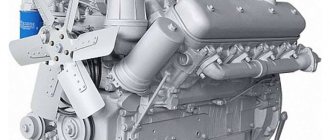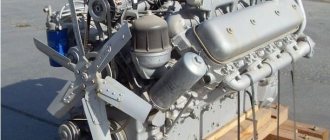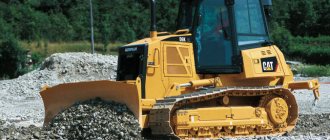ZIL-130 is a Soviet-Russian truck produced in the period 1962-2014. This model became one of the most popular trucks of the Soviet era. The car received a large number of modifications intended for civil and military needs. In particular, there is a modification with a load capacity of 6 tons. At the same time, the ZIL-130 is a typical medium-duty truck, which is located between the GAZ-3 models and the more powerful and heavier MAZ-500 truck. ZIL-130 is the successor to the outdated ZIL-164 model. It is noteworthy that in 1986 the car received a new standardized index - ZIL-431410. The ZIL-130 version was equipped with rear-wheel drive, but all-wheel drive trucks were also produced on the basis of this vehicle.
ZIL design
For its time, the basic ZIL-130 was a fairly powerful car, and the fact that the ZIL 130 has such high fuel consumption per 100 km is due to this. The car has an engine equipped with 8 cylinders. All modifications of this model have power steering, as well as a 5-speed gearbox. It uses A-76 fuel for movement.
| Engine | Consumption (highway) | Consumption (city) | Consumption (mixed cycle) |
| ZIL 130 | 25 l/100 km | 35 l/100 km | 30 l/100 km |
Dimensions and weight
The truck has the following parameters:
- length/width/height – 6.37/2.5/2.65 meters;
- distance between front/rear wheels – 1.93/1.85 m;
- ground clearance - 33 centimeters;
- cooling system volume – 26.5 liters;
- net weight of the platform – 860 kilograms;
- the weight of the assembled gearbox is 200 kilograms, and the same figure for the cabin is 0.55 tons.
The total weight of the vehicle is about 11.5 tons with a full load, which allows it to withstand driving over bridges and other engineering structures on the roads.
How much fuel does ZIL consume?
ZIL is a dump truck, so it consumes quite a lot of fuel. The fuel consumption of ZIL 130 is 31.5 liters according to official data.
This figure is indicated in all documentation, but it corresponds to reality only when the machine is relatively unloaded and in good condition. And yet, it is more interesting to know what the real fuel consumption is for the ZIL 130.
Increase in norm
There are circumstances under which the average fuel consumption on a ZIL increases for every hundred kilometers.
Such a circumstance may be the time of year.
And now let’s talk about how costs are increasing
:
- in the southern regions the change is insignificant - only about 5%;
- in the temperate climate zone there is an increase in fuel consumption by 10%;
- a little further north the flow rate will already increase to 15%;
- in the Far North, in Siberia - up to 20% increase.
Having this data at hand, it is easy to calculate what gasoline consumption is on a ZIL 130 in winter. For example, if you do the math (taking the norm as 31.5 cubic meters), then a car will spend at least 34.5 cubic meters of gasoline for a kilometer distance in a temperate climate in winter.
Linear fuel consumption also increases with increasing mileage - we wear out the engine. Here the statistics are as follows
:
- new car – mileage up to 1000 km – increase by 5%;
- for every new thousand km driven – an increase of 3%.
Fuel consumption varies depending on the terrain you drive on. It's no secret that the fuel consumption of the ZIL 130 on the highway is less than normal, and is usually 28-32 liters for every 100 km
. On the highway you have to stop less, the road is better there, you can gain stable speed and not overwork the engine. Cars of this brand most often drive along the highway, because trucks of this type are designed to move cargo over long distances.
As drivers say, fuel consumption rates for the ZIL 130 in the city are increasing significantly. The dump truck has to constantly maneuver, stand at traffic lights, pedestrian crossings, and maintain a speed that is not as high as it could develop on the highway, which is why gasoline consumption increases. In urban conditions it is 38-42 liters per 100 kilometers.
Where are ZIL-131 trucks used?
Despite the increased amount of fuel consumed, the ZIL-131 truck was specially optimized and adapted for off-road use. For this purpose, the manufacturer provides a reinforced bridge design. The tires have 8 layers and a special tread pattern. This increases and improves grip on the road surface. Additionally, the cargo vehicle is modified with a center differential. Model 131 is different from other cars. In terms of its characteristics and parameters, it is not inferior to tracked vehicles. In wartime, the car was installed to arm the Katyusha. This model was also used for unified normal dimensions. Advantages include the possibility of installing a covered van. It transports service stations and points for providing radio communications. Now this technique is also used at military training grounds. The truck was used in aviation. It was equipped with equipment that made it possible to service aircraft. In urban conditions, the ZIL-131 model served as snow removal equipment. At enterprises you can find this truck as a tank for transporting oil, gasoline, and other combustion products. ZIL-131 is used in fire departments. This is the most common modification used in urban environments.
Fuel economy
Prices for gasoline and diesel do not stand still - they are rising every day. Drivers, in order to save their money, have to come up with special tricks to save money. It “eats” a lot, and switching to gas will be ineffective. Some of them are used for ZIL-130
.
- Without significant increases, ZIL consumes fuel, which is in good technical condition, especially regarding the condition of the engine, carburetor, and vehicle ignition system.
- Fuel consumption can be reduced by taking a few minutes to warm up the engine in winter.
- A person's driving style can also affect a car's fuel consumption: they should drive more calmly and avoid sudden starts and braking. Consumption is also lower when driving faster.
- If possible, avoid busy streets in the city - gasoline consumption on them increases by 15-20%.
Source
The value of MTZ-82 for agriculture
This suggests that it is suitable for the full cycle of agricultural work, from preparing the land before planting crops and ending with the necessary work assigned to equipment such as a tractor. When choosing an engine for a commercial vehicle, and especially a truck, of course, you should pay attention not only to efficiency, but also to engine power.
Fuel consumption ZIL 130
ZIL 130 is a Soviet truck model equipped with a 5-speed gearbox. Production began in 1962 and continued after the collapse of the Soviet Union in Russia until 2014. Initially, the truck was equipped with a 150 hp gasoline engine, later models with a diesel engine and a gas cylinder with a capacity of 140 and 120 hp appeared on the market. Fuel consumption on trucks depends on the type of engine, operating conditions, and condition of the vehicle.
Fuel consumption ZIL 130 per 100 km
Fuel consumption of ZIL 130 depends on:
- Obstacles on the way - pedestrian crossings, traffic jams. On the highway at high speed, fuel consumption will be less than when driving around the city.
- Body load. Initially, the technical documentation stated a load capacity of 6 tons, but this truck is capable of “pulling” 8. In this case, fuel consumption will increase by 10-15%.
- Pre-warming the engine before driving in the cold season. A warm engine consumes less fuel
- Technical condition. A new or just repaired car always consumes less gasoline or diesel fuel. Therefore, owners should maintain the truck’s mechanisms in good technical condition to avoid unnecessary waste of fuel.
Diesel engine
For a ZIL diesel engine, fuel consumption per 100 km is 20-25 liters. If the load is exceeded, poor technical condition, driving in cold weather and around the city with a large number of stops, this value can increase to 30 l/100 km.
Consumption of ZIL 130 with gasoline engines
For 100 kilometers, a gasoline engine consumes 30-35 liters of fuel. Truck owners consider this type of engine to be the most expensive, preferring, if possible, to install diesel or gas equipment on a dump truck.
ZIL 130 with HBO
Gas is cheaper than gasoline, so if they want to save money, future ZIL buyers opt for models with gas-cylinder equipment. There are 2 versions of the gas cylinder for ZIL - 138A and 130I. The first has a power of 120 hp, the second produces 135. Fuel consumption is 30-35 liters of gas per 100 km - depending on the type of route, weather conditions and the condition of the car.
The advantage of a ZIL truck with gas-cylinder equipment is the ability to convert the engine to gasoline without additional tricks. The engine power will increase to 160 hp.
Pendant History of creation
| Measuring the fuel consumption of a ZIL 131 with a D245 engine. When installing the piston, flat-shaped steel rings are installed in such a way that the locks of the annular disks are at an angle of 180 to one another. The front bushing on the fan side, made of aluminum alloy, is equipped with a thrust collar that holds the camshaft from axial movement; the remaining bushings are made of special cast iron. |
- the direction of the arrow that is on the bottom is towards the front of the crankshaft;
- the direction of the arrow and the mark that is on the connecting rod rod is in one direction - this rule applies when a kit is installed in the assembly for cylinders located on the left (left group);
- The direction of the mark on the connecting rod rod and the arrows are in different directions - this is how the kit should be installed for cylinders located on the right (right group).
ZIL 130 owner reviews about consumption
Ruslan, Leningrad region
I bought a ZIL produced in 1993 and drove it for 5 years. Fuel consumption was 30-35 liters per 100 km, but when loaded the engine consumed 5-7 liters more than when the body was half empty.
I drive a ZIL-130, manufactured in 1995, I keep an eye on the condition of the car, fortunately it’s easy to sort through the engine in the garage with my buddies, and getting a spare part is not a problem. The engine is gasoline; on the highway, with a load of 6 tons, it consumes 25 l/100 km; when driving around the city, it requires 30 l/100 km. The hardest thing is off-road - there it reaches 35 l/100 km.
I was warned about the gluttony of the gasoline engine when I was planning the purchase. I didn’t listen, and later discovered that a loaded dump truck consumes up to 40 l/100 km. I freaked out and installed a diesel engine. I have never regretted it - in 7 years it has paid for itself more than once, because... consumption is now a maximum of 25 liters of diesel fuel.
I bought a ZIL-130 1991 specifically to service a construction site. The original gasoline engine on the 92 worked flawlessly, even if it had to pull 8 tons. I didn’t like the gas mileage, so I installed the MT3-80 diesel. Now it consumes a maximum of 20 l/100 km, while the load capacity remains the same.
I live in a rural area, I have my own farm, so a truck is necessary. I bought a 130 model with a 130I engine to run on both gas and gasoline. It consumes more gas - 34-36 liters, but it also costs less. If you fill with 92 gasoline, it comes out to 30-32 liters per 100 km.
Source
Power System – Lubrication System
International certification of four modifications of the D-245 for compliance with Euro-4 standards took place in 2011, and their mass production began in January 2012. Dobrynya was first presented at the Commercial Vehicles exhibition back in 2006 and throughout its production and operation it has earned flattering reviews from both experts in the use of the vehicle and its sales.
| intake and exhaust cylinder 1 | exhaust cylinder 4 |
| exhaust cylinder 2 | exhaust cylinder 5 |
| intake cylinder 3 | intake cylinder 7 |
| intake cylinder 6 |
Engine for a ZIL 130 car: characteristics, malfunctions and tuning
Nowadays you can find a huge amount of goods. It can be divided not only by quality, but also by cost. It is worth noting that this also applies to the automotive market. And this is quite natural. After all, every manufacturer wants to make a huge profit from sales and invest less money. During the Soviet era, the ZIL 130 engine, which was distinguished by its good strength and durability, gained enormous popularity.
Many drivers said that this is simply an indestructible unit that does not require much attention. The first vehicle with the ZIL 130 engine was released at the beginning of 1962. This was the first truck to roll off the Moscow assembly line.
Design of the D-245 diesel engine. About the history of the model
The axial force of the crankshaft is perceived by 4 bimetallic or aluminum alloy half rings, which are installed in the bores of the BC and the cover of the 5th main bearing. They are distinguished not only by high reliability, but also by efficiency when operating in any weather conditions, which makes MMZ engines indispensable for heavy equipment: tractors, loaders, excavators and buses.
| Manufacturer | MMZ |
| Type of gas exchange system | with turbocharging and ONV |
| Power (kW/hp) | 100/136 |
| Rated speed (rpm) | 2400 |
| dimensions | 1011*702*1080 mm |
| Weight | 530 kg |
Description
The ZIL 130 engine was installed on all trucks, both ZIL 130 and ZIL 131. And this is not surprising. After all, if you look at the design, the ZIL 131 engine is very similar to the standard ZIL 130 engine.
These units had a small degree of unification. To put it simply, the power unit from the Zil 130 was slightly reduced in volume, to 6 liters, which made it possible to obtain lower fuel consumption. The power unit also received a two-chamber carburetor system and a special speed limiter.
The more powerful engine is the ZIL 375, which has a volume of about seven liters. This type of machine is mainly used at the Ural Automobile Plant. Thanks to this, it was possible to obtain an increased cylinder radius and piston stroke.
Specifications
The technical characteristics of the ZIL 130 engine deserve special attention.
| PARAMETER | MEANING |
| Model | ZIL 130 |
| Power unit type | Gasoline, four-stroke, carburetor |
| Power | 148 hp at 3000 rpm (with limiter) |
| Number of cylinders | 8 |
| How the cylinders are arranged | At an angle of 90 degrees |
| Minimum cylinder diameter and piston stroke | 100 mm diameter and 95 mm stroke |
| Total engine capacity | 6 liters |
| Compression ratio | About 6.5 |
| Minimum power at 3200 rpm | 150 horsepower or 110 kW |
| Torque at 2000 rpm | 401 Newtons per meter |
| Fuel consumption of the ZIL 130 engine | 313 grams |
| How cylinders work | 1 – 5 – 4 – 2 – 6 – 3 – 7 — 8 |
| Cylinder numbering: | Right 1 – 2 – 3 – 4 |
| Left 5 – 6 – 7 – 8 | |
| Total engine weight | 640 kilograms |
| Engine pusher ZIL 130 | Made of quality steel, has a slight overlay of cast iron, fully mechanical |
| Gas pipelines of the ZIL 130 engine | The intake is made of aluminum alloy, has a special cavity for heating the fuel mixture, and is located between the cylinder heads |
| The outlet is made of high-quality cast iron, located one on each side of the block | |
| Oil pump for ZIL 130 engine | Has several sections; gear, located on the right side of the cylinder block, the pressure reducing valve has a pressure of 320 kPa. In the lower section, oil is supplied to the oil cooler, the bypass valve has a pressure of 120 kPa. |
| Cleaning filters for the ZIL 130 engine | |
| Fine cleaning | Ceramic filter elements, equipped with economizer and pump |
| settling tank | Located on a bracket, has a slot type |
| Radiator | Has three rows, snake type |
The motor is installed on the following car models: ZIL 130, 131, 375 and 508.
I would also like to note that the ZIL 508 engine has three compression rings and one oil scraper ring. The thermostat of the ZIL 508 engine deserves special attention. It has a solid filling and is installed in the exhaust pipe. The ZIL 131 engine cooling system is based on liquid, a completely closed type with forced circulation.
If we talk about the piston pin, then the ZIL 375 engine has it made of steel, completely hollow and floating. This refers to a certain feature of the car. The flywheel for the ZIL 375 engine is made of high-quality cast iron, equipped with a steel crown for starting the power unit from the starter. Speaking about the power supply system of the ZIL 375 engine, it contains the principle of forced supply of a portion of fuel.
Fuel consumption standards for special and specialized vehicles
Appendix to the order of the Ministry of Transport of the Russian Federation dated March 14, 2008 No. AM-23-r
Last modified: May 14, 2014, July 14, 2015, April 6, 2022, September 20, 2022
Fuel consumption standards for special and specialized vehicles
Special and specialized vehicles with equipment installed on them are divided into two groups:
— vehicles performing work during the parking period (firefighting truck cranes, tank trucks, compressor, drilling rigs, etc.);
— vehicles performing repair, construction and other work while moving (aerial platforms, cable laying machines, concrete mixers, etc.).
The standard fuel consumption (l) for special vehicles performing the main work during the parking period is determined as follows:
Qн = (0.01 x Hsс x S + Hт x T) x (1 + 0.01 x D), l (5)
where Hsс is the fuel consumption rate for mileage, l/100 km (in cases where a special vehicle is also intended to transport cargo, the individual rate is calculated taking into account the performance of transport work:
Hsc' = Hsc + Hw x W,
where Hw is the rate of fuel consumption for transport work, l/100t * km;
W — volume of transport work, t * km);
S is the mileage of the special vehicle to the place of work and back, km;
Ht is the rate of fuel consumption for the operation of special equipment (l/h) or liters for the operation performed (filling a tank, etc.);
T—equipment operating time (hours) or number of operations performed;
D - total relative increase or decrease to the norm, as a percentage (when operating equipment, only allowances for work in winter and in mountainous areas are applied).
Standard fuel consumption (l) for special vehicles that perform the main work during movement is determined as follows:
Qн = 0.01 x (Hsс x S' + Hs" x S") x (1 + 0.01 x D), (6)
where Hsс is the individual fuel consumption rate for the mileage of a special vehicle, l/100 km;
S' — mileage of the special vehicle to the place of work and back, km;
Hs" - fuel consumption rate for mileage when performing special work while moving, l/100 km;
S"—vehicle mileage when performing special work while moving, km;
D - total relative increase or decrease to the norm, % (when operating equipment, only allowances for work in winter and in mountainous areas are applied).
For vehicles on which special equipment is installed, fuel consumption standards for mileage (for movement) are established based on fuel consumption standards developed for basic car models, taking into account changes in the weight of the special vehicle.
Fuel consumption standards for special vehicles performing housing and communal services are determined according to the standards of the Housing and Communal Services Department of the Gosstroy of Russia (K.D. Pamfilov Academy of Public Utilities).
15.1. Telescopic aerial platforms
| Model of a special or specialized vehicle | Basic model | Norm for car mileage, l/100 km | Equipment operating norm, l/h |
| 1 | 2 | 3 | 4 |
| AG-60 | GAZ-51 | 26,5 | 3,0 |
| AGP-12 | GAZ-52 | 28,5 | 3,0 |
| AGP-12 | GAZ-53 | 30,5 | 3,5 |
| AGP-12A | GAZ-53A | 30,5 | 3,5 |
| AGP-12B | ZIL-164 | 35,0 | 3,5 |
| AGP-18.04 (ZIL-508.10-8V-6.0-150-5M) | ZIL-43662 | 39.3 B | ** |
| AGP-22 (ZIL-508.10-8V-6.0-150-5M) | ZIL-431412 | 40.2 B | ** |
| AGP-22.04 (D-243MMZ-4L-4.75-81-5M) | ZIL-431412 | 20.5 D | ** |
| AP-17 | GAZ-53A | 32,0 | 3,5 |
| APK-30 | Ural-375 | 66,0 | 5,0 |
| AT-53G | GAZ-53A | 27,5 | 3,5 |
| VI-23 | ZIL-130 | 35,0 | 4,0 |
| VS-18 MS | GAZ-52-03 | 27,5 | 3,0 |
| VS-22 (ZIL-508.10-8V-6.0-150-5M) | ZIL-131 | 48.5 B | ** |
| VS-22 MS | ZIL-130 | 38,5 | 4,0 |
| VS-26 MS | ZIL-130 | 39,5 | 4,0 |
| GVG | GAZ-51 | 26,5 | 3,0 |
| MShTS-2A | ZIL-157, ZIL-157 1C | 50,0 | 3,5 |
| MShTS-3A | ZIL-130 | 41,4 | 4,0 |
| SPO-15, -15M | Ural-375 | 77,5 | 5,0 |
| TV-1 | GAZ-51 | 26,5 | 3,0 |
| TV-1 | GAZ-52 | 25,0 | 3,0 |
| TV-1 | GAZ-53, GAZ-53F | 30,5 | 3,0 |
| TV-2 | GAZ-52-03 | 26,0 | 3,0 |
| TV-23 | ZIL-131 | 46,0 | 4,0 |
| TVG-15 | GAZ-51A | 27,0 | 3,0 |
15.2. Drilling rigs
| Model of a special or specialized vehicle | Basic model | Norm for car mileage, l/100 km | Equipment operating norm, l/h | |
| 1 | 2 | 3 | 4 | |
| AVB-2M | GAZ-66 | 31,0 | 8,0 | |
| BKGM-63AN | GAZ-53 | 31,0 | 7,5 | |
| BKMA-1/3.5 | ZIL-130 | 37,0 | 12,0 | |
| BM-202A, -202 (BKGM-66-2) | GAZ-66A | 31,0 | 8,0 | |
| BM-302A, -32 (BKGM-66-3) | GAZ-66 | 31,0 | 8,0 | |
| BM-802S | KrAZ-257 | 54,5 | 8,0 | |
| LBU-50 | ZIL-157K | 44,5 | 8,0 | |
| MRK-1A | ZIL-157 | 46,0 | 8,0 | |
| MRK-3A | ZIL-131 | 46,0 | 8,0 | |
| MRKA-690A | ZIL-130 | 42,0 | 12,0 | |
| OBUDM-150 343 | ZIL-157 | 48,0 | 8,0 | |
| OBUE-150 ZIV | ZIL-157K | 44,5 | 8,0 | |
| URB-2A | ZIL-157K | 47,5 | 8,0 | |
| URB-16 | ZIL-157K | 45,5 | 8,0 | |
| URB-50M | GAZ-66 | 32,0 | 8,0 | |
15.3. Disinfection units
| Model of a special or specialized vehicle | Basic model | Norm for car mileage, l/100 km | Equipment operating norm, l/h |
| 1 | 2 | 3 | 4 |
| DUK-1 | GAZ-51 | 23,0 | 6,0 |
| DUK-1 | GAZ-63 | 27,0 | 6,0 |
| DUK-2 | GAZ-51 | 23,0 | 16,0 |
| OTV-1 | GAZ-51 | 23,0 | 6,0 |
15.4. Cable layers
| Model of a special or specialized vehicle | Basic model | Norm for car mileage, l/100 km | Equipment operating norm, l/h | |
| 1 | 2 | 3 | 4 | |
| KM-2M | GAZ-63 | 30,0 | 7,0 | |
| P-3229 | ZIL-130 | 37,0 | 10,0 | |
15.5. Kinomovedvizhki
| Model of a special or specialized vehicle | Basic model | Norm for car mileage, l/100 km | Equipment operating norm, l/h | |
| 1 | 2 | 3 | 4 | |
| Automovie mover AFV-51-2 | GAZ-51A | 24,0 | 5,0 | |
| Avtokinoperedvizhka AM-2 | UAZ-452 | 18,0 | 4,0 | |
| Autoclub G1A1 "Kuban" | GAZ-52 | 28,0 | 1,0 | |
| Autoclub G1A2 "Kuban" | GAZ-53A | 30,0 | 1,0 | |
| Autoclub "Uralets" | GAZ-53A | 30,0 | 1,0 | |
| "Kubanets 1A" | UAZ-452 | 18,0 | 1,0 | |
| Mobile theater and cinema | GAZ-51 | 24,0 | 1,0 | |
| Mobile theater and cinema | GAZ-52 | 28,0 | 1,0 | |
15.6. Compressors
| Model of a special or specialized vehicle | Basic model | Norm for car mileage, l/100 km | Equipment operating norm, l/h | ||
| 1 | 2 | 3 | 4 | ||
| APKS-6 | ZIL-130 | 33,0 | 9,0 | ||
| PKS-5 | ZIL-164 | 33,0 | 11,0 | ||
15.7. Automotive cranes
| Model of a special or specialized vehicle | Basic model | Norm for car mileage, l/100 km | Equipment operating norm, l/h |
| 1 | 2 | 3 | 4 |
| AK-5 | ZIL-130 | 38,0 | 5,0 |
| AK-75, -75V | ZIL-130, ZIL-431412 | 40,0 | 6,0 |
| AK-75 | ZIL-164 | 39,0 | 6,0 |
| GKM-5 | ZIL-130 | 38,0 | 5,0 |
| GKM-5 | ZIL-164 | 39,0 | 6,0 |
| GKM-6.5 | MAZ-500 | 30,5 | 5,5 |
| K-2.5-12, -2.5-13 | GAZ-51A | 26,5 | 4,5 |
| K-46 | ZIL-130 | 38,0 | 5,0 |
| K-51 | MAZ-200 | 34,0 | 5,0 |
| K-51M | MAZ-500 | 33,0 | 6,0 |
| K-64 | MAZ-500 | 31,0 | 5,0 |
| K-67 | MAZ-500 | 30,5 | 5,0 |
| K-68, -69, -69A | MAZ-200 | 34,0 | 5,0 |
| K-104 | KrAZ-257 | 55,0 | 6,0 |
| K-104 | KrAZ-219 | 62,0 | 6,0 |
| K-162 (KS-4571A) | KrAZ-258 | 52,0 | 8,4 |
| K-162 (KS-4561), -162С | KrAZ-257 | 59,0 | 8,8 |
| KS-1561, -1562, -1562A | GAZ-53A | 33,0 | 5,0 |
| KS-1571 | GAZ-53-12 | 32,0 | 5,0 |
| KS-2561, -2561D, -2561E, -2561K, -2561K1, -2571 | ZIL-130, ZIL-431412 | 40,0 | 6,0 |
| KS-2573 | Ural-43202 | 38,0 | 6,0 |
| KS-3561 | MAZ-500 | 33,0 | 6,0 |
| KS-3561A, -3562, -3562A | MAZ-500A | 33,0 | 6,0 |
| KS-35628 | MAZ-5334 | 33,0 | 6,0 |
| KS-3574 (KAMAZ-740-8V-10.85-220-5M) | Ural-5557 | 46.0 D | ** |
| KS-3574 (YaMZ-236-6V-11.15-184-5M) | Ural-5557 | 45.0 D | ** |
| KS-3575 | ZIL-133GYA | 33,0 | 6,0 |
| KS-4561A, -4561AHL | KrAZ-257 | 56,0 | 8,8 |
| KS-4571 | KrAZ-257 | 52,0 | 8,4 |
| KS-4572 | KamAZ-53213 | 31,0 | 6,0 |
| KS-4576 (YaMZ-238M-8V-14.86-240-5M) | KrAZ-250 | 57.0 D | ** |
| KS-5479 (YaMZ-238D-8V-14.86-330-8M) | MZKT-8006 | 40.0 D | ** |
| KS-55713 (YaMZ-238M-8V-14.86-240-5M) | Ural-4320- | 55.8 D | ** |
| KS-5573 | MAZ-7310 | 125,0 | 18,0 |
| LAZ-690 | ZIL-130, ZIL-164 | 37,0 | 5,5 |
| MKA-10G | MAZ-500 | 33,0 | 5,0 |
| MKA-10M | MAZ-200 | 38,0 | 5,5 |
| MKA-10M | MAZ-500 | 34,0 | 5,0 |
| MKA-16 | KrAZ-257 | 57,0 | 8,8 |
| MSK-87 (ZIL-508.10-8V-6.0-150-5M) | ZIL-130 | 44.0 B | ** |
| SMK-7 | MAZ-200 | 34,0 | 5,0 |
| SMK-10 | MAZ-500 | 34,0 | 5,0 |
| KS-45717K-1 (KAMAZ-740.11-8V-10.85-240-10M) | KamAZ-53229 | 37.5 D | ** |
| KS-55713-4 (KAMAZ-740.13-8V-10.85-260-5M) | KamAZ-53228N | 44.6 D | ** |
| KS-55729 (YaMZ-236BE-6V-11.15-250-8M) | MAZ-630303 | 44.3 D | ** |
15.7.1. Automotive cranes domestic and CIS countries produced since 2008
| Model, brand, modification of the car | Number and arrangement of cylinders | Engine power, hp | Working volume, l | checkpoint | Basic fuel consumption rate, l/100 km |
| 1 | 2 | 3 | 4 | 5 | 6 |
KS | |||||
| 45117 (Ural highway-4320; YaMZ-NE2-24) | 6V | 230 | 11,15 | 5M | 45.4D |
| 45717K-1 (mine KamAZ-53229; KamAZ-740.31) | 8V | 240 | 10,85 | 10M | 40.0D |
| 45721 (mine URAL-4320; YaMZ-236NE2-24) | 6V | 230 | 11,15 | 5M | 45.1D |
URAL | |||||
| 4320 MKT 25 (YaMZ-236NE2-24) | 6V | 230 | 11,15 | 5M | 46.0D |
| 5557-1151-40 (YAMZ-236NE2-3) | 6V | 230 | 11,15 | 5M | 41.3D |
Akran | |||||
| ChS-2784KV (mine KamAZ-43108; KamAZ-740.31) | 8V | 224 | 10,85 | 5M | 32.3D |
| MKT-25.1 (mine KamAZ-65115; KamAZ-740.62) | 8V | 280 | 11,76 | 10M | 40.8D |
15.8. Labs in cars
| Model of a special or specialized vehicle | Basic model | Norm for car mileage, l/100 km | Equipment operating norm, l/h |
| 1 | 2 | 3 | 4 |
| AVP-39231 | GAZ-66-11 | 32,0 | — |
| Dor. lab. (ZMZ-402.10-4L-2,445-100-5M) | GAZ-33023 | 17.5 B | — |
| KSP-2001 | GAZ-66-11 | 32,0 | — |
| KSP-2002 | GAZ-66-11 | 32,5 | — |
| Counter-weight lab. (UMZ-4215СО-4L-2.89-110-5М) | GAZ-2705 | 17.5 B | — |
| LKDP-39521 | GAZ-66-11 | 32,5 | — |
| Maud. 39121 | UAZ-3151201 | 17,0 | — |
| Maud. 3914 | UAZ-220601 | 18,0 | — |
| OMS-2 | GAZ-51 | 25,5 | 3,0 |
| PPZK-3924 | GAZ-66-11 | 32,0 | — |
| PPZK-3928 | PAZ-672M | 39,0 | — |
| ETL-10 | GAZ-51 | 25,5 | 5,0 |
| ETL-10 | GAZ-53 | 30,0 | 5,0 |
| ETL-35-01 | GAZ-51 | 25,0 | 4,0 |
| ETL-35-01 | GAZ-63 | 29,0 | 4,0 |
| Maud. 2811-000001-04 (road laboratory) (UMZ-421500-4L-2.89-89-5M) | GAZ-2705 | 18.3 B | — |
| (UMZ-421500-4L-2.89-89-5M) | GAZ-2705 | 18.3 B | — |
| Maud. 2977 (lab.) (ZMZ-40522-4L-2,464-140-5M) | GAZ-2705 | 16.8 B | — |
| Dor. lab. (UMZ-4215SR-4L-2.89-96-5M) | GAZ-2705 | 19.0 B | — |
| Autolab. (ZMZ-40630S-4L-2.3-110-5M) | GAZ-27057 | 17.7 B | — |
| Lab. (ZMZ-40630-4L-2.3-98-5M) | GAZ-27057/AL-28510A | 18.4 B | — |
| Dor. lab. (ZMZ-4063-4L-2.3-98-5M) | GAZ-32217 | 17.6 B | — |
| RE lab. (D-245.7-4L-4.75-117-5M) | GAZ-33081 | 16.5 D | — |
| GAZ-38473-0000010 (road laboratory) (UMZ-421500-4L-2.89-89-5M) | GAZ-2705 | 17.5 B | — |
| VL2 (ZIL-508.10-8V-6.0-150-5M) | ZIL-433362 VL2 | 44.5 B | — |
15.9. Winches on car chassis
| Model of a special or specialized vehicle | Basic model | Norm for car mileage, l/100 km | Equipment operating norm, l/h |
| 1 | 2 | 3 | 4 |
| GAZ-63 | — | 3,0 | |
| ZIL-131 | — | 5,0 | |
| ZIL-157K | — | 4,0 | |
| KamAZ-5320 | 3,0 | ||
| KrAZ-257 | — | 5,0 | |
| MAZ-200 | — | 3,0 | |
| MAZ-500 | — | 3,0 | |
| SAZ-3502 | — | 4,0 | |
| Ural-375 | — | 6,0 | |
| Ural-4320 | — | 3,0 |
15.10. Workshops on cars
| Model of a special or specialized vehicle | Basic model | Norm for car mileage, l/100 km | Equipment operating norm, l/h |
| 1 | 2 | 3 | 4 |
| AVM-1 | GAZ-51 | 25,0 | 3,5 |
| AT-63 | GAZ-53A | 26,0 | 3,5 |
| ATU-A | GAZ-51 | 25,0 | 4,0 |
| ATU-A | GAZ-63 | 27,0 | 4,0 |
| GOSNITI-2 | GAZ-51 | 25,0 | 4,0 |
| GOSNITI-2 | GAZ-63 | 29,5 | 4,0 |
| LV-8A (T-142B) | ZIL-131 | 52,0 | 4,0 |
| Maud. 39011 | GAZ-52-01 | 25,0 | 3,5 |
| Maud. 39021 | GAZ-66-11 | 30,0 | 4,0 |
| Maud. 39031 | GAZ-66-11 | 31,0 | 4,0 |
| Auto mechanic. (D-245.7E2-4L-4.75-117-5M) | GAZ-33081 | 20.3 D | ** |
| GAZ-4795-10-33 (D-245.7-4L-4.75-117-5M) | GAZ-33081 | 18.9 D | ** |
15.11. Loaders
| Model of a special or specialized vehicle | Basic model | Norm for car mileage, l/100 km | Equipment operating norm, l/h |
| 1 | 2 | 3 | 4 |
| 4000M | 27,5 | 5,0 | |
| 4001 | 38,0 | 5,0 | |
| 4003, 4006 | 40,0 | 6,0 | |
| 4008 | 54,0 | 6,0 | |
| 4008M engine ZIL-120 | 46,5 | 6,0 | |
| 4008M engine ZIL-130 | 54,5 | 6,0 | |
| 4009 | 54,0 | 6,0 | |
| 4013 | 27,5 | 5,0 | |
| 4014 | 40,0 | 5,0 | |
| 4016 | 43,0 | 5,0 | |
| 4018 | 33,0 | 5,0 | |
| 4020 | 12,0 | 2,5 | |
| 4022-01 | 18,0 | 3,0 | |
| 4028 | 53,5 | 6,0 | |
| 4043, 4043M | 28,0 | 5,0 | |
| 4045, 4045M, 4046 | 40,0 | 6,0 | |
| 4049 | 45,0 | 5,0 | |
| 4055M | 31,0 | 5,5 | |
| 4063 | 28,0 | 5,0 | |
| 4065 | 29,0 | 5,0 | |
| 4070 | 54,5 | 6,0 | |
| 4081 | 29,5 | 5,0 | |
| 4091 | 13,0 | 2,5 | |
| 40912 | 18,0 | 2,0 | |
| 4092 | 20,0 | 3,0 | |
| 4312-01 | 33,0 | 6,0 | |
| 7806 | 73,5 | 6,0 | |
| 7806 YaMZ-238 engine | 110,0 | 6,0 | |
| VK-10 | 30,0 | 5,5 | |
| UP-66 | 33,0 | 5,5 |
15.12. Firefighting vehicles
| Model of a special or specialized vehicle | Basic model | Liquid fuel consumption rate | |||
| for car mileage l/100 km | When the engine is running with special units*, l/min | When the engine is running in stationary mode without load, l/min | |||
| 1 | 2 | 3 | 4 | 5 | |
| AC-30 (53A) mod. 106B | GAZ-53A | 32,00 | — | 0,110 | |
| AC-2.9-30 (53A) mod. 106V | GAZ 53-12 | 33,00 | — | 0,110 | |
| AC-30 (53-12) mod. 106G | GAZ 53-12 | 33,50 | — | 0,110 | |
| ATs-30 (3307) mod. 226 | GAZ-3307 | 33,50 | — | 0,110 | |
| ATs-10 (53-12) simplified | GAZ-53-12 | 33,50 | 0,200 | 0,110 | |
| ATs-10 (3307) simplified | GAZ-3307 | 33,50 | 0,200 | 0,110 | |
| AC-30 (66) mod. 146 | GAZ-66 | 34,00 | 0,275 | 0,110 | |
| ATsL-30 (66) mod. 147A, 147-01 | GAZ-66 | 34,00 | 0,275 | 0,110 | |
| AC-30 (66) mod. 184, 184A | GAZ-66 | 33,50 | 0,275 | 0,110 | |
| AC 0.8-4(5301FB) mod. PM-541 | ZIL-5301 FB 4x4 | 22,00 | 0,200 | 0,060 | |
| AC 1.5-30/2(5301) mod. 2-MM | ZIL-5301 4x2 | 18,50 | 0,220 | 0,060 | |
| AC 1.5-40/4 (5301) | ZIL-5301 | 18,50 | 0,220 | 0,060 | |
| ATs 2-4(5301) PM-542, AC 1.820(5301) | ZIL-5301 | 19,00 | 0,200 | 0,060 | |
| ATs-40 (130)-63A | ZIL-130 | 40,50 | 0,330 | 0,150 | |
| AC-40 (130) mod. 63B | ZIL-130 | 41,50 | 0,330 | 0,150 | |
| AC-40 (431412) mod. 63B | ZIL-431412 | 41,50 | 0,330 | 0,150 | |
| AC 2.5-40 (4333) PM-540 | ZIL-4333 | 41,50 | 0,330 | 0,150 | |
| AC 3.0-40/4 (433104) | ZIL-4331 | 33,00 | 0,250 | 0,110 | |
| AC-3.0-40 (433104), ATs-40 (433104) 001-MM | ZIL-4331 | 33,00 | 0,240 | 0,110 | |
| ATs 4-40 (433104) mod. 540A | ZIL-4331 | 33,00 | 0,240 | 0,110 | |
| ATs-40 (433362) | ZIL-4333 | 41,50 | 0,330 | 0,150 | |
| ATs-20/200 (433104) | ZIL-4331 | 32,50 | 0,250 | 0,110 | |
| AC-40 (131) mod. 42B | ZIL-131 | 51,50 | 0,330 | 0,150 | |
| AC-40 (131) mod. 137, 137A | ZIL-131 | 51,00 | 0,330 | 0,150 | |
| AC-40 (131) mod. 153 | ZIL-131 | 52,00 | 0,330 | 0,150 | |
| AC-40/3 (131C) mod. 153A | ZIL-131S | 51,00 | 0,330 | 0,150 | |
| AC-40 (131) mod. 1-Thu | ZIL-131 | 51,00 | 0,330 | 0,150 | |
| ATs 2.5-40 (131N) mod.6-VR | ZIL-131N | 51,00 | 0,330 | 0,150 | |
| ATs-40 (133ГЯ) mod. 181A | ZIL-133GYA | 35,0 | 0,250 | 0,150 | |
| TLF-2200 Rosenbauer AC-2.0-40/4 (4331-04) | ZIL-4331 | 33,00 | 0,250 | 0,150 | |
| AC-40 (133G1) mod. 181 | ZIL-133G1 | 54,50 | 0,330 | 0,150 | |
| ATs-40 (375)TS1 mod.102A | Ural-375 | 64,50 | 0,360 | 0,200 | |
| ATs 3-40/4 (4325) mod. 3-PS | Ural-4320 | 39,00 | 0,250 | 0,150 | |
| AC-40 (43202) mod. 1-PS | Ural-43202 | 40,50 | 0,250 | 0,150 | |
| AC 6.0-40 (5557) | Ural-5557 | 44,50 | 0,330 | 0,200 | |
| ADC 6/6-40 (55571-10) | Ural-5557 | 42,00 | 0,250 | 0,150 | |
| AC 8.0-40 (5557) | Ural-5557 | 47,00 | 0,330 | 0,200 | |
| ADC 8/6-40 (55571-30) | Ural-5557 | 47,50 | 0,330 | 0,200 | |
| AC 8.0-40/4 (4320) | Ural-4320 | 46,00 | 0,250 | 0,150 | |
| ADC 9/3-40 (55571-30) | Ural-5557 | 50,30 | 0,330 | 0,200 | |
| AC-40 (43202) mod. PM 102B | Ural-43202 | 40,50 | 0,250 | 0,150 | |
| ATs-4/40 (5557) IR mod. 002 | Ural-5557 | 42,50 | 0,330 | 0,200 | |
| ADC-40-6/3 (5557-10) | Ural-5557 | 43,00 | 0,250 | 0,150 | |
| ATsPS-6/6-40 (55570) | Ural-5557 | 43,00 | 0,330 | 0,150 | |
| ATsPA-9/3-60 (4320-30) | Ural-4320 | 42,00 | 0,300 | 0,150 | |
| AC 3-40 (4326) mod. PM-536 | KamAZ-43101 | 35,00 | 0,250 | 0,150 | |
| AC-40 (43101) mod. 001-IR | KamAZ-43101 | 39,00 | 0,250 | 0,150 | |
| ATsL 3-40-17(4925) mod. 537 | KamAZ-4925, 43101 | 39,50 | 0,250 | 0,150 | |
| AC 5-40 (4925) mod. PM-536 | KamAZ-4925, 43101 | 39,50 | 0,250 | 0,150 | |
| AC 5.0-40 (4310) mod. PM-524 | KamAZ-43101 | 40,00 | 0,250 | 0,150 | |
| ATs-6-40/4(53211) mod. TLF 6500 Rosenbauer | KamAZ-53211 | 40,00 | 0,250 | 0,150 | |
| TLF 6500 ATs6.0-40/4 (53211) mod.1-DD | KamAZ-53211 | 44,50 | 0,250 | 0,150 | |
| AC 7.0-40 (53213) mod. 524 | KamAZ-5320 | 39,00 | 0,250 | 0,150 | |
| ATs 7-40/4 (53213) | KamAZ-5320 | 39,00 | 0,250 | 0,150 | |
| ATs-40/4(53211) mod. 240 | KamAZ-53212 | 39,00 | 0,250 | 0,150 | |
| AC-TLF Magirus-Deutz | Magirus-Deutz | 32,00 | 0,300 | 0,200 | |
| ATs-7-40(53229) mod.524 | KamAZ-5320 | 39,00 | 0,250 | 0,150 | |
| AB-40(43202) mod.187, AC-40 (43202) mod. 187 | Ural-43202 | 41,00 | 0,250 | 0,150 | |
| AB-20 (53213) | KamAZ-53213 | 44,50 | 0,250 | 0,150 | |
| AA-40(131) mod. 139 | ZIL-131 | 50,50 | 0,330 | 0,150 | |
| AA-40(43105) mod. 189 | KamAZ-43105 | 40,00 | 0,250 | 0,150 | |
| AA-60 (7313) mod.160.01, | MAZ-7313, 7310 | 110,00 | 0,400 | 0,200 | |
| AN-40(130E) mod.127 | ZIL-130E | 39,00 | 0,330 | 0,150 | |
| ANR-40(130) mod.127A | ZIL-130, 4314 | 38,50 | 0,330 | 0,150 | |
| ANR-40(431410) mod.127B | ZIL-431410 | 38,50 | 0,330 | 0,150 | |
| AR-2(131) mod. 133 | ZIL-131 | 50,00 | 0,330 | 0,150 | |
| AR-2(43101) PM | KamAZ-43101 | 35,50 | 0,250 | 0,150 | |
| AR-2(43105) mod. 215 | KamAZ-43105 | 40,00 | 0,250 | 0,150 | |
| PNS-110(131) mod.131, 131A | ZIL-131 | 50,5 | — | 0,150 | |
| (for doors 2D-12B) | 1,100 | 0,350 | |||
| AP-3(130) mod.148A | ZIL-130 | 41,00 | — | 0,150 | |
| AP-4(43105) mod.222 | KamAZ-43105 | 40,50 | — | 0,150 | |
| AP-5(53213) mod. 196 | KamAZ-53213 | 38,00 | — | 0,150 | |
| ACT-0.5/0.5(66) mod.207 | GAZ-66 | 33,00 | 0,275 | 0,110 | |
| ACT-3/2.5(133ГЯ) mod. 197 | ZIL-133GYA | 38,50 | 0,250 | 0,200 | |
| AGVT-150(375) mod.168 | Ural-375 | 65,00 | 0,350 | 0,200 | |
| AGVT-100(131) mod. 141 | ZIL-131 | 49,50 | 0,330 | 0,150 | |
| AL-30(131) mod. 21 and 22 | ZIL-131 | 49,00 | 0,250 | 0,150 | |
| AL-30(131) mod. PM-506V | ZIL-131 | 49,00 | 0,250 | 0,150 | |
| AL-30(43105) mod. PM-512 | KamAZ-43105 | 40,50 | 0,200 | 0,150 | |
| AL-30(4310) mod. PM-512 | KamAZ-43101 | 39,00 | 0,200 | 0,150 | |
| AL-45(257) mod. PM-109 | KrAZ-257 | 48,50 | 0,350 | 0,200 | |
| AL-50 Magirus-Deutz | Magirus-Deutz | 52,00 | 0,350 | 0,150 | |
| AL-50(53229) | KamAZ-5320 | 44,50 | 0,250 | 0,150 | |
| AL-37(53212) | KamAZ-5320 | 37,00 | 0,250 | 0,150 | |
| AKP-30(53213) mod. PM-509A | KamAZ-53213 | 41,50 | 0,200 | 0,110 | |
| AKP-30(53213) mod. 509B | KamAZ-53213 | 41,50 | 0,200 | 0,110 | |
| KP-Bronto-330(53213) | KamAZ-53213 | 45,00 | 0,200 | 0,110 | |
| APT-26(4310) rise. telescope. | KamAZ-4310 | 39,00 | 0,200 | 0,150 | |
| ATSO-20(375) mod. 114 | Ural-375 | 61,00 | 0,360 | 0,200 | |
| ASO-12(66) mod.90A | GAZ-66 | 32,50 | 0,200 | 0,110 | |
| ASO-8(66) | GAZ-66 | 33,50 | 0,180 | 0,110 | |
| ASO-(672), AG-(672) | PAZ-672 | 36,00 | 0,200 | 0,110 | |
| ASO-20(3205) | PAZ-3205 | 36,00 | 0,200 | 0,110 | |
| ATSO-20(43101) | KamAZ-43101 | 36,00 | 0,200 | 0,150 | |
| AT-3(131) mod. T2 | ZIL-131 | 50,00 | 0,350 | 0,150 | |
| AG-12(3205), AG(3205) | PAZ-3205 | 36,00 | 0,200 | 0,110 | |
| AG-24(130) mod. 198 | ZIL-130 | 39,00 | 0,330 | 0,150 | |
| AD 45/20(3302) | GAZ-3302 | 19,00 | 0,160 | 0,080 | |
| AD-80/1200(66-11) | GAZ-66-11 | 32,50 | 0,200 | 0,110 | |
| AD-90(66) mod. 187 | GAZ-66 | 33,00 | 0,200 | 0,110 | |
| ASH-5(452) mod. 79B | UAZ-452 | 18,00 | — | 0,060 | |
| ASh-5(452) mod. 79A | UAZ-3741 | 18,00 | — | 0,060 | |
| ASH-5(22034) | RAF-22034 | 16,50 | — | 0,060 | |
| ASH-5(39620) | UAZ-3962, 37411 | 19,00 | — | 0,060 | |
| ASH-6(3205) | PAZ-3205 | 36,00 | — | 0,110 | |
| ALP-5(3962) | UAZ-3962 | 19,00 | — | 0,060 | |
| ALP-6(452) mod. 173 | UAZ-452 | 18,00 | — | 0,060 | |
| ALP-30(66-11) forest patrol vehicle. | GAZ-66-11 | 33,00 | 0,275 | 0,110 | |
| 8ТЗ11(131) | ZIL-131 | 50,00 | 0,275 | 0,150 | |
| ASA-4(3302) mod. 541 | GAZ-3302 Gazelle | 19,00 | 0,160 | 0,080 | |
| ASA-16(43101) | KamAZ-43101 | 39,50 | 0,250 | 0,150 | |
| ASA-4(131) | ZIL-131 | 50,00 | 0,330 | 0,150 | |
| ASA-20(4310) mod. 523 | KamAZ-43101 | 38,00 | 0,250 | 0,150 | |
| APRSS-3(3962) | UAZ-3962 | 19,00 | — | 0,060 | |
| ASP(2131) | VAZ-2131 “Niva” 4x4 | 13,90 | — | 0,150 | |
| ASML-41accident-rescue auto | VAZ | 13,90 | — | 0,150 | |
| APS-41 emergency rescue car | VAZ | 13,90 | — | 0,150 | |
| APP-2(3302) mod. 002 | GAZ-3302 | 19,00 | 0,160 | 0,080 | |
| APP-05(3302) mod. 003 | GAZ-3302 | 19,00 | — | 0,080 | |
| UKS-400V-131 | ZIL-131 | 50,00 | — | 0,150 | |
| AA-5.3/40-50/3(4310) | KamAZ-43101 | 41,00 | 0,330 | 0,150 | |
| Bronto F-52 HDT | Bronto | 52,00 | 0,390 | 0,150 | |
| KP-Bronto-Sky-Elevator-50 | Bronto (SISU) | 63,00 | 0,260 | 0,280 | |
| KP Bronto-50-2T1 | Bronto | 52,00 | 0,200 | 0,110 | |
| AL DLK-53 Mercedes-Benz | Mercedes Benz | 65,00 | 0,435 | 0,150 | |
| AV-20 (KAMAZ-740.10-8V-10.85-210-5M) | KamAZ-532130 | 37.0 D | ** | ** | |
| AC-3.0-40 (ZIL-508.10-8V-6.0-150-5M) | ZIL-4334 | 39.6 B | ** | ** | |
| ADC-40-6/3 (YaMZ-236M2-6V-11.15-180-5M) | Ural-5557-10 | 34.4 D | ** | ** | |
______________________________
* For fire trucks that have a speedometer trip meter when operating a special unit, the liquid fuel consumption rate is not established.
In this case, fuel consumption is taken into account based on the speedometer reading and the liquid fuel consumption rate per 100 km.
15.12.1. Firefighting vehicles domestic and CIS countries produced since 2008
| Model, brand, modification of the car | Number and arrangement of cylinders | Engine power, hp | Working volume, l | checkpoint | Basic fuel consumption rate, l/100 km |
| 1 | 2 | 3 | 4 | 5 | 6 |
AC | |||||
| 0,8-40/2 (sh. ZIL-530104; D-245.9 E2) | 4L | 130 | 4,75 | 5M | 19.5D |
| 0.8-40/2-002-MM (sh. ZIL-530104; D-245.12S) | 4L | 109 | 4,75 | 5M | 19.0D |
| 2,5-40 (mine KamAZ-4308; Cummins B5.9 180) | 6L | 178 | 5,88 | 5M | 22.6D |
| 2,5-40 (mine KamAZ-4308; Cummins 4IS Bel85) | 4L | 185 | 4,461 | 5M | 22.0D |
| 2.5-40-6VR (Highway AMUR-5313; D-245.30E3) | 4L | 152 | 4,75 | 5M | 24.0D |
| 3,0-40 (mine KamAZ-4308; Cummins 4ISBe 185) | 4L | 185 | 4,461 | 5M | 21.1D |
| 3,0-40 PSA mod. 1 MI (Ural highway 43206; YaMZ-236NE2-24) | 6V | 230 | 11,15 | 5M | 29.5D |
| 3,2-40 (sh. ZIL-433112; ZMZ-508300) | 8V | 134 | 6,00 | 5M | 37,4 |
| 3,2-40 (4308)-38VR (KAMAZ-4308; Cummins 4ISBe 185) | 4L | 180 | 4,461 | 5M | 21.9D |
| 3,2-40/2 (sh.ZIL-43314; ZIL 509.10) | 8V | 175 | 7,0 | 5M | 42,7 |
| 3,2-40/4 (mine KamAZ-43253; Cummins 6ISBe 210) | 6L | 210 | 6,692 | 6M | 23.7D |
| 5,0-40 (mine KamAZ-43253; Cummins 4ISBe210) | 8V | 210 | 6,7 | 5M | 23.9D |
| 5,5 (Ural highway 43206; YaMZ-236M2) | 6V | 180 | 11,15 | 5M | 27.3D |
| 5,5-40 Maud. 005-MI (58410K; w. Ural 5557; YaMZ-236NE 2-24) | 6V | 230 | 11,15 | 5M | 32.8D |
| 5.5-40 mod. 005-MI (Ural highway 5557; YaMZ-236NE2-24) | 6V | 230 | 11,15 | 5M | 32.2D |
| 6,0-40 (Kamaz highway 43118; KamAZ-740.31) | 8V | 224 | 10,85 | 5M | 34.1D |
| 6,0-40 mod.006-MI-03 (mine URAL-4320; YaMZ-236NE2) | 6V | 230 | 11,15 | 5M | 35.2D |
| 7,5-40 (Ural highway 4320; YaMZ-236NE 2-24) | 6V | 230 | 11,15 | 5M | 33.3D |
KamAZ | |||||
| 5662 CH AA 13/60 (KAMAZ-740.63) | 8V | 400 | 11,76 | 8M | 44.5D |
| 4563 (Cummins 4ISBe210) | 6L | 210 | 6,692 | 6M | 24.6D |
GROOVE | |||||
| AG-16 (sh. PAZ-3205; D-245.7E2) | 4L | 122 | 4,75 | 5M | 20.8D |
| AG-16-01NN (sh. PAZ-3205; ZMZ-5232.10) | 8V | 130 | 4,67 | 4M | 33,8 |
PSA | |||||
| 48470A 2.0-40/2 (43206) (highway Ural-43206; YaMZ-236NE2-24) | 6V | 230 | 11,15 | 5M | 31.4D |
| 2.0-40/2 (43206) mod. 008MI (highway Ural-43206; YaMZ-236NE2-24) | 6V | 230 | 11,15 | 5M | 34.1D |
15.12.2. Foreign fire fighting vehicles since 2008
| Model, brand, modification of the car | Number and arrangement of cylinders | Engine power, hp | Working volume, l | checkpoint | Basic fuel consumption rate, l/100 km |
| 1 | 2 | 3 | 4 | 5 | 6 |
Iveco | |||||
| AMT Trakker ASM-20.AMT (container module) | 6L | 420 | 12,880 | 16M | 41.6D |
| Magirus DLK 23-12 NB CS | 6L | 275 | 5,883 | 4A | 34.4D |
| Magirus DLK 55CS | 6L | 352 | 7,790 | 16M | 47.8D |
| Magirus DLK23-12 GLT CS | 6L | 275 | 5,883 | 9M | 33.8D |
| Magirus M32L-AS (ladder) | 6L | 299 | 5,880 | 6M | 31.9D |
| Magirus Multistar (lift) | 6L | 275 | 5,883 | 8M | 32.8D |
| Magirus RW Daily 65C15D | 4L | 146 | 2,998 | 6M | 14.1D |
| Magirus RW Daily 65C18D | 4L | 177 | 2,998 | 6M | 15.5D |
| Magirus Snorkel GTLF27/70 WT300 (foam lifter) | 6L | 450 | 12,880 | 12A | 53.9D |
| Magirus Super Dragon ARFE 14000DP 250 HRET 15 (airfield) | 8V | 1024 | 20,080 | 6A | 72.4D |
| Magirus TLF 30/25-2 | 6L | 252 | 5,883 | 6M | 29.4D |
| TFFV (for extinguishing fires in tunnels) | 6L | 340 | 7,790 | 6A | 36.8D |
| Trakker AD380T44 (foam lifter) | 6L | 440 | 12,880 | 16M | 40.6D |
| Trakker DLK 55CS (ladder truck) | 6L | 360 | 7,790 | 6A | 50.1D |
Liebherr | |||||
| LTM 1070-4,IF (crane) | 6L | 367 | 10,520 | 12M | 75.7D |
| LTM1045-3.1F (crane) | 6L | 367 | 9,960 | 12M | 63.1D |
15.13. Bitumen trucks
| Model of a special or specialized vehicle | Basic model | Liquid fuel consumption rate | ||
| for car mileage l/100 km | For 1 hour bitumen pump operation, l | For 1 hour Tank heater work, l. | ||
| 1 | 2 | 3 | 4 | 5 |
| D-642 | ZIL-130V1 | 37,5 | 8,0 | 3,0 |
| DS-10 (D-351) | KrAZ-258 | 51,0 | 10,0 | 3,5 |
| DS-39A (D-640A) | ZIL-130 | 34,5 | 8,0 | 3,0 |
| DS-41A (D-642A) | ZIL-130V1 | 38,0 | 8,0 | 3,0 |
| DS-53A (D-722A) | ZIL-130V1 | 41,0 | 8,0 | 3,0 |
| DS-96 | ZIL-130V1 | 38,5 | 8,0 | 3,0 |
| MV-16 | GAZ-53A | 32,0 | 6,0 | 2,5 |
15.14. Tarmac trucks
| Model of a special or specialized vehicle | Basic model | Liquid fuel consumption rate | ||
| for car mileage l/100 km | For 1 hour of asphalt distributor work, l. | For 1 hour Bitumen pump work, l. | ||
| 1 | 2 | 3 | 4 | 5 |
| D-164A | MAZ-500 | 31,5 | 6,0 | 8,0 |
| D-251A | ZIL-164 | 34,0 | 10,0 | 8,0 |
| D-640A (DV-39A) | ZIL-130V1 | 34,5 | 10,0 | 8,0 |
| D-642 (DS-53A) | ZIL-130V1 | 40,5 | 10,0 | 8,0 |
15.15. Self-loading vehicles
| Model of a special or specialized vehicle | Basic model | Liquid fuel consumption rate | ||
| for car mileage l/100 km | For loading and unloading a set of containers, l. | |||
| A-130F, -853 | GAZ-53-12 | 27,0 | 2,1 | |
| NIIAT P-404 | GAZ-53A | 28,0 | 4,2 | |
| U-77 | GAZ-52-04 | 25,0 | 2,2 | |
| U-77 | GAZ-53A | 28,0 | 2,3 | |
| TsPKTB-A130, -A130F | GAZ-53A | 28,0 | 2,3 | |
| TsPKTB-A130V1 | ZIL-130V1 | 37,5 | 2,2 | |
| TsPKTB-A133 | ZIL-133GYA | 27,0 | 3,0 | |
| TsPKTB-A53213 | KamAZ-53213 | 27,0 | 3,0 | |
| 4030P | GAZ-53-04 | 25,0 | 2,5 | |
| 4030P | GAZ-53A | 28,0 | 3,0 | |
| 4030P | ZIL-130AN | 34,0 | 3,0 | |
15.16. Fuel tankers and oil tankers
| Model of a special or specialized vehicle | Basic model | Liquid fuel consumption rate | |
| for car mileage l/100 km | For filling and draining one tank, l. | ||
| 1 | 2 | 3 | 4 |
| AVZ-50 | GAZ-51A | 24,0 | 2,0 |
| ATZ-2.2-51A | GAZ-51A | 25,0 | 2,0 |
| ATZ-3-157K | ZIL-157K | 40,0 | 3,0 |
| ATZ-3.8-53A | GAZ-53A | 27,0 | 3,0 |
| ATZ-3.8-130 | ZIL-130 | 33,0 | 3,0 |
| ATMZ-4.5-375 | Ural-375 | 53,0 | 4,0 |
| ATsTMM-4-157K | ZIL-157K | 40,0 | 3,0 |
| LV-7 (MA-4A) | ZIL-131 | 43,0 | 3,0 |
| MZ-51M | GAZ-51A | 24,0 | 2,0 |
| MZ-66, -66-01, -66A-01 | GAZ-66 | 30,0 | 2,4 |
| MZ-3904 | GAZ-63 | 28,0 | 2,2 |
| Maud. 4611 | ZIL-495710 | 33,5 | 3,0 |
| T-8-255B | KrAZ-255B | 44,0 | 4,0 |
| TZ-7.5-500A | MAZ-500A | 26,0 | 3,0 |
| TZ-500 | MAZ-500 | 25,0 | 3,0 |
| 3607 | GAZ-52-01 | 23,0 | 2,0 |
| 3608 (ATZ-2.4-52) | GAZ-52-01 | 23,5 | 2,0 |
| 3609 | GAZ-52-04 | 23,0 | 2,0 |
| ATZ-124320 (YaMZ-236NE2-6V-11.15-230-5M) | URAL-4320 | 34.9 D | ** |
| ATZ-56132 (KAMAZ-740.10-8V-10.85-210-5M) | KamAZ-53212 | 30.9 D | ** |
| ATZ-56142 (YaMZ-238M2-8V-14.86-240-5M) | MAZ-5337-041 | 30.6 D | ** |
15.16.1. Domestic and CIS fuel tankers and oil tankers manufactured since 2008
| Model, brand, modification of the car | Number and arrangement of cylinders | Engine power, l"s. | Working volume, l | checkpoint | Basic fuel consumption rate, l/100 km |
| 1 | 2 | 3 | 4 | 5 | 6 |
| ATZ-56480A (mine URAL-5557; YaMZ-236) | 6V | 180 | 11,15 | 5M | 29.8D |
15.16.2. Foreign fuel tankers and oil tankers manufactured since 2008
| Model, brand, modification of the car | Number and arrangement of cylinders | Engine power, hp | Working volume, l | checkpoint | Basic fuel consumption rate, l/100 km |
| 1 | 2 | 3 | 4 | 5 | 6 |
| Exterer | |||||
| T3A-5(FTW-5) (s. MB Atego 1018; airfield) | 4L | 177 | 4,249 | 6M | 20.0D |
15.17. Tank vehicles
| Model of a special or specialized vehicle | Basic model | Liquid fuel consumption rate | |
| for car mileage l/100 km | For filling and draining one tank*, l. | ||
| 1 | 2 | 3 | 4 |
| AVV-2M | GAZ-51A | 22,0 | 2,0 |
| AVV-3.6 | GAZ-53-12-01 | 25,5 | 3,0 |
| AVV-3.6 | GAZ-53A | 26,0 | 3,0 |
| AVV-3.8 | GAZ-53A | 26,0 | 3,0 |
| AVTs-1.5-63 | GAZ-63 | 27,0 | 2,3 |
| AVTs-1.7 | GAZ-66 | 29,0 | 2,3 |
| AC (D-243MMZ-4L-4.75-81-5M) | GAZ-53-12 | 15.7 D | ** |
| ATs (KAMAZ-740.11-8V-10.85-240-10M) | KamAZ-53215 | 30.6 D | ** |
| ATs (YaMZ-238-8V-14.86-240-5M) | KamAZ-5320 | 27.0 D | ** |
| AC-1.9-51A, -2.0-51A | GAZ-51A | 22,0 | 2,0 |
| AC-2.4-52 | GAZ-52-01 | 23,0 | 2,2 |
| AC-2.6-53F, -2.9-53F | GAZ-53F | 22,0 | 2,0 |
| AC-2.6-355M | Ural-355M | 32,0 | 2,5 |
| AC-3.8-164A. -4-164A | ZIL-164A | 32,0 | 3,0 |
| AC-4.2-53A | GAZ-53A | 26,0 | 3,0 |
| ATs-4.2-130 | ZIL-130 | 32,0 | 3,5 |
| AC-4.3-130 | ZIL-130 | 33,5 | 3,0 |
| ATs-8-5334, -8-5435 | MAZ-5334 | 24,0 | 3,0 |
| ATsL-147 | GAZ-66 | 29,0 | 2,5 |
| ACM-2.6-355M | Ural-355M | 31,0 | 3,0 |
| ATsPT-1.5 | GAZ-51A | 23,0 | 2,0 |
| ATsPT-1.7 | GAZ-66 | 30,0 | 3,0 |
| ATsPT-1.9 | GAZ-51A | 22,5 | 2,0 |
| ATsPT-2.1 | GAZ-52-01 | 24,0 | 2,2 |
| ATsPT-2.8 | GAZ-53A | 26,0 | 3,0 |
| ATsPT-2.8 | ZIL-164 | 33,0 | 2,5 |
| ATsPT-2.8-130 | ZIL-130 | 33,0 | 3,0 |
| ACPT-3.3, -3.8 | GAZ-53A | 26,0 | 3,0 |
| ACPT-5.6, -5.7 | MAZ-500 | 25,5 | 3,0 |
| ATsPT-6.2 | MAZ-5335 | 25,5 | 3,0 |
| Maud. 46101 | Ural-43203 | 33,5 | 3,0 |
| Maud. 3613 | GAZ-5312 | 25,5 | 3,0 |
| TSV-6 | ZIL-130 | 32,0 | 3,0 |
| TSV-7 (ZIL-508.10-8V-6.0-150-5M) | ZIL-431418 | 36.5 B | ** |
| ATs-46123-011 (ZIL-Z75-8V-7.0-180-5M) | ZIL-433360 | 38.6 B | ** |
| ATs-7-4310 (KAMAZ-740.10-8V-10.85-210-10M) | KamAZ-4310 | 30.7 D | ** |
| ATs-8.500 (YaMZ-238M2-8V-14.86-240-8M) | MAZ-500 | 26.8 D | ** |
| G6 OPA-5336 (YaMZ-238M2-8V-14.86-240-5M) | MAZ-53366 | 29.3 D | ** |
| G6 OPA-5336/1 (YaMZ-238DE2-8V-14.86-330-9M) | MAZ-533605-241 | 31.4 D | ** |
______________________________
* The norm does not apply when filling and draining by gravity.
15.17.1. Tank vehicles produced since 2008
| Model, brand, modification of the car | Number and arrangement of cylinders | Engine power, hp | Working volume, l | checkpoint | Basic fuel consumption rate, l/100 km |
| 1 | 2 | 3 | 4 | 5 | 6 |
ATS | |||||
| 565877 (machine MA3-63 03A5; YaMZ-6582.10) | 8V | 330 | 14,86 | 8M | 32.6D |
| 565846 (mash. MAZ 5336A; YaMZ 6562.10) | 6V | 250 | 11,15 | 8M | 28.2D |
| 56132-000001-32 (w. MA3-5376A3; YaMZ 6562.10) | 6V | 250 | 11,15 | 8M | 28.2D |
15.18. Cement trucks and concrete mixer trucks
| Model of a special or specialized vehicle | Basic model | Liquid fuel consumption rate | |
| for car mileage l/100 km | For loading and blowing one tank, l. | ||
| 1 | 2 | 3 | 4 |
| ABS-7 (KAMAZ-740.11-8V-10.85-240-10M) | KamAZ-53229 | 29.4 D | ** |
| BN-80-20 | KrAZ-257B1 | 50,0 | 5,0 |
| RP-1 | ZIL-130V1 | 36,0 | 3,0 |
| C0571 | ZIL-164A | 36,5 | 3,0 |
| S-570A | MAZ-200V | 32,0 | 3,0 |
| S-571 | ZIL-164A | 36,5 | 3,0 |
| S-571 | ZIL-130V1 | 37,5 | 3,0 |
| S-942 | KrAZ-258 | 41,0 | 5,0 |
| S-956 | GAZ-53B | 29,0 | 2,5 |
| S-1036B | MAZ-500 | 27,0 | 4,5 |
| SB-89 | ZIL-130 | 35,0 | 3,0 |
| SB-89B1 | ZIL-431412 | 35,0 | 3,0 |
| SB-92 | KrAZ-258 | 42,0 | 5,0 |
| SB-92 (KAMAZ-740-8V-10.85-220-5M) | KamAZ-55111 | 39.5 D | ** |
| SB-113 | ZIL-130 | 33,0 | 3,0 |
| SB-239 (KAMAZ-7403.10-8V-10.85-260-5M) | KamAZ-6540 | 33.7 D | ** |
| TC-2A (S-652A) | KrAZ-258B | 50,0 | 5,0 |
| TC-3 (S-853), -3A (S-853A) | ZIL-130V1 | 38,0 | 3,0 |
| TC-4 (S-927) | ZIL-130V1 | 37,5 | 3,0 |
| TC-6 (S-972) | MAZ-504A | 29,0 | 4,5 |
| TC-10 | ZIL-130V1 | 38,5 | 3,0 |
| TC-11 | KamAZ-5410 | 31,5 | 3,0 |
| U-5A | ZIL-130V1 | 39,0 | 3,0 |
| 42184-OZPS | KrAZ-258B1 | 55,5 | 5,0 |
| ABS-580711 (KAMAZ-740.31-8V-10.85-240-8M) | KamAZ-53229R | 30.0 D | ** |
| MAN 33.360 (6L-11,967-360-16M) | 34.5 D | ** | |
| Volvo FM 12 (6L-12,1-420-14M) | 35.4 D | ** | |
_____________________________
** Fuel consumption standards for the operation of special equipment installed on vehicles are determined according to data from manufacturers of special and specialized vehicles, l/h.
15.18.1. Foreign-made cement trucks and concrete mixer trucks since 2008
| Model, brand, modification of the car | Number and arrangement of cylinders | Power engine, hp | Working volume, l | checkpoint | Basic fuel consumption rate, l/100 km |
| 1 | 2 | 3 | 4 | 5 | 6 |
Mercedes-Benz | |||||
| Actros 332B | 6L | 320 | 11,946 | 16M | 31.9D |
Volvo | |||||
| FEE 6x4 Liebherr HTM 704 | 6L | 320 | 7,146 | 6A | 36.3D |
15.19. Armored vehicles of domestic and CIS countries produced since 2008
| Model, brand, modification of the car | Number and arrangement of cylinders | Engine power, hp | Working volume, l | checkpoint | Basic fuel consumption rate, l/100 km |
| 1 | 2 | 3 | 4 | 5 | 6 |
VAZ | |||||
| 2170 "Priora" (VAZ-21126-67) | 4L | 133 | 1,596 | 5M | 9,3 |
KamAZ | |||||
| 43269 "Shot" (KAMAZ-740.31) | 8V | 240 | 10,85 | 5M | 33.7D |
| ASPTs 671011 (mine KamAZ-65115; KamAZ 740.62) | 8V | 280 | 11,76 | 10M | 33.0D |
UAZ | |||||
| 31631 "Patriot" (Iveco FI A) | 4L | 116 | 2,287 | 5M | 10.7D |
| 3163-10 "Patriot" (ZMZ-409.10) | 4L | 128 | 2,693 | 5M | 14,5 |
DISA | |||||
| 29521 (sh.G AZ-2752; ZMZ-40522A) | 4L | 140 | 2,464 | 5M | 16,4 |
| 29521 (m.rA3-2752;Chrysler) | 4L | 133,3 | 2,429 | 5M | 15,8 |
| 295214 (highway GAZ-2752; ZMZ-405240) | 4L | 133,3 | 2,464 | 5M | 16,5 |
LAURA | |||||
| 19541-0000010-03 (highway GAZ-27057; ZMZ-45240) | 4L | 123,8 | 2,464 | 5M | 18,0 |
| 21214 (VAZ-21214) | 4L | 81 | 1,69 | 5M | 11,9 |
Warrior | |||||
| 29453 (highway GAZ-2705; ZMZ-405240) | 4L | 123,8 | 2,464 | 5M | 16,4 |
RIDA | |||||
| 297611 (highway GAZ-2705; ZMZ-40522) | 4L | 140 | 2,464 | 5M | 16,8 |
| 299910 (highway GAZ-3102; ZMZ-40621A) | 4L | 130 | 2,285 | 5M | 13,2 |
15.19.1. Foreign armored vehicles since 2008
| Model, brand, modification of the car | Number and arrangement of cylinders | Engine power, hp | Working volume, l | checkpoint | Basic fuel consumption rate, l/100 km |
| 1 | 2 | 3 | 4 | 5 | 6 |
Laura | |||||
| 29804 (Ford Ranger) | 4L | 143 | 2,449 | 5M | 12.2D |
Audi | |||||
| A8L 6.0 quattro | 12W | 450 | 5,998 | 6A | 20,0 |
Chevrolet | |||||
| Suburban 8.1 4WD | 8V | 344 | 8,128 | 4A | 27,0 |
Ford | |||||
| Transit 2.4D | 4L | 140 | 2,402 | 6M | 13.2D |
| Transit Connect 1.8TDCi | 4L | 90 | 1,753 | 5M | 9.5D |
Mercedes-Benz | |||||
| S600 | 12V | 517 | 5,513 | 5A | 22,6 |
| S600 4Matic | 12V | 517 | 5,513 | 7A | 20,6 |
| S600 | 12V | 517 | 5,513 | 7A | 20,0 |
| S600L | 12V | 517 | 5,513 | 5A | 22,0 |
| S600L B6/B7 | 12V | 517 | 5,513 | 5A | 22,5 |
| S600LIVM XXL | 12V | 517 | 5,513 | 5A | 23,8 |
| Sprinter 315CDI | 4L | 150 | 2,148 | 5M | 13.4D |
| Sprinter 524 | 6V | 258 | 3,498 | 5A | 19,2 |
RIDA | |||||
| 397640 (VW Caddy) | 4L | 105 | 1,896 | 5M | 8,ID |
Volkswagen | |||||
| Crafter 50 2EKZ 2.5TDI | 5L | 163 | 2,461 | 6M | 14.5D |
| Crafter 50 2EKEZ 2.0BiTDi 4Motion | 4L | 163 | 1,968 | 6M | 13.8D |
| Caddy 2.0D | 4L | 69 | 1,968 | 5M | 7.7D |
| Transporter 2.0TD | 4L | 140 | 1,968 | 6M | 9.9D |
| Transporter 2.5TDI | 5L | 131 | 2,461 | 6M | 10.3D |
| Transporter 2.5TDI 4Motion | 5L | 131 | 2,461 | 6M | 11.7D |
| Transporter T5 2.0BiTDI | 4L | 180 | 1,968 | 6M | 10.3D |
DISA | |||||
| 296121 (VW Transporter 4Motion 2.5 TDI) | 5L | 131 | 2,461 | 6M | 10.5D |
| 29615 (Ford Transit 330 SWB 4Motion) | 4L | 140 | 2,402 | 6M | 12.7D |
| 29615 (FordTransitVan 330) | 4L | 145 | 2,261 | 5M | 13,6 |
| 29615 (FordTransit) | 4L | 116 | 2,402 | 6M | 12.3D |
NAME | |||||
| M-19282 (FordTransit) | 4L | 140 | 2,402 | 6M | 12.3D |
| M-19282 (Ford Transit 2.2TDCi 4 Motion) | 4L | 125 | 2,198 | 6M | 10.8D |
| M-19282 (FordTransit 330SWB) | 4L | 155 | 2,198 | 6M | 10.1D |
| M-3006 (FordTransit 2.2TDi) | 4L | 155 | 2,198 | 6M | 13.6D |
| M-3006 (Ford Transit 460) | 4L | 140 | 2,402 | 6M | 13, ID |
RIDA | |||||
| 396930 (Lexus LX570) | 8V | 367 | 5,663 | 6A | 18,5 |
| 397600 (VW Transporter 2.5 TD) | 5L | 131 | 2,461 | 6M | 11.0D |
| 397610 (VW Transporter 2.0 4Motion) | 4L | 116 | 1,984 | 5M | 13,6 |
| 397931 (Toyota Camry 3.5) | 6V | 277 | 3,456 | 6A | 13,5 |
Knight | |||||
| 294541-02 (VW Transporter) | 5L | 131 | 2,461 | 6M | 11.7D |
| 294541-04 (VW T5 2.0BiTDI) | 4L | 180 | 1,968 | 6M | 11.7D |
| 294541-06 (VW Transporter 2.0TDI 4Motion) | 4L | 140 | 1,968 | 6M | 9.7D |
| 294544-01 (VW Caddy) | 4L | 105 | 1,896 | 5M | 8,ID |
15.20. Cars for transporting suspects, temporarily prisoners and accused, domestic and CIS countries, produced since 2008
| Model, brand, modification of the car | Number and arrangement of cylinders | Engine power, hp | Working volume, l | checkpoint | Basic fuel consumption rate, l/100 km |
| 1 | 2 | 3 | 4 | 5 | 6 |
GAS | |||||
| 3295A3 (24m; highway GA3-3309; D-245.7EZ) | 4L | 119 | 4,75 | 5M | 18.7D |
| 3309AZ-2 (26m; D-245.7E3) | 4L | 119 | 4,75 | 5M | 18.9D |
KamAZ | |||||
| 4308A3-2 (43m; Cummins4ISbel 85) | 4L | 185 | 4,461 | 5M | 21.3D |
| 43114A3 (36m; KamAZ-740.31) | 8V | 224 | 10,85 | 5M | 38.9D |
| 651 PAZ (56 m; Cummins 6ISBe 300) | 6L | 300 | 6,692 | 9M | 32.1D |
15.20.1. Staff cars produced since 2008
| Model, brand, modification of the car | Number and arrangement of cylinders | Engine power, hp | Working volume, l | checkpoint | Basic fuel consumption rate, l/100 km |
| 1 | 2 | 3 | 4 | 5 | 6 |
AS | |||||
| 7(2705)-01MM (UMZ-421600) | 4L | 107 | 2,89 | 5M | 15,5 |
- Back
- Forward
Design
If you look at the design of the engine, it is based on a four-stroke eight-cylinder unit with a carburetor system with a constant fuel supply.
A small feature is the V-shaped arrangement of the cylinders. Due to this, it is possible to obtain very high power and low weight of the engine.
All pistons and cylinders are driven by one crankshaft.
The power unit also has a liquid cooling system, which is very convenient. The car owner will be able to drive in any weather.
The lubrication system has a combined system: high pressure and splashing. Thanks to this, all parts of the ZIL 130 engine will receive their portion of oil and will not fail.
The engine power supply system of ZIL 375 and 130 is very similar. Their fuel is supplied forcefully and constantly, which is very cool. Due to this, the power unit will work without interruption.
Modifications
Separately, I would like to talk about some modifications of the ZIL 130 engine. The fact is that in Soviet times they tried to design a vehicle that would last a long period of time.
- The first cars were equipped with a simple carburetor engine with a V-shaped cylinder arrangement. This system had an engine capacity of 5,200 cubic centimeters. After some time, everyone became convinced that it was technically impossible to develop the potential that was required.
- Because of this, the designers produced the same V-shaped unit, but with eight cylinders. Due to this, it was possible to increase power to 150 horsepower, which is very good. Neither the ZIL 357 engine nor the ZIL 131 brand engine could boast of such potential.
- Next, the designers released a completely new motor, which allowed it to accelerate to 90 kilometers per hour. The main features include a four-stroke cycle and overhead valve arrangement.
Cylinder head
Diesel engines D-260 and their modifications are 4-stroke, piston, six-cylinder internal combustion engines, with a single-row, vertical cylinder arrangement, equipped with a direct fuel injection system and ignition of the fuel mixture from compression. At first glance, the power ratings are insufficient for engines of this volume, but in reality this MMZ engine provides excellent traction even for heavy modifications of ZILs and various trucks.
Service
In this section it is worth talking about changing the oil. This process is very easy to do.
To do this you should:
- Unscrew the drain plug;
- Unscrew the oil filter plug and drain the oil;
- Unscrew the nut and remove the oil filter cover;
- Remove the metal and rubber seal;
- Remove the oil filter and remove the rod;
- The filter should be changed in the reverse order;
- Fill in the oil and let the power unit run for 5 minutes;
- Check the oil level using the dipstick and top up if necessary.
